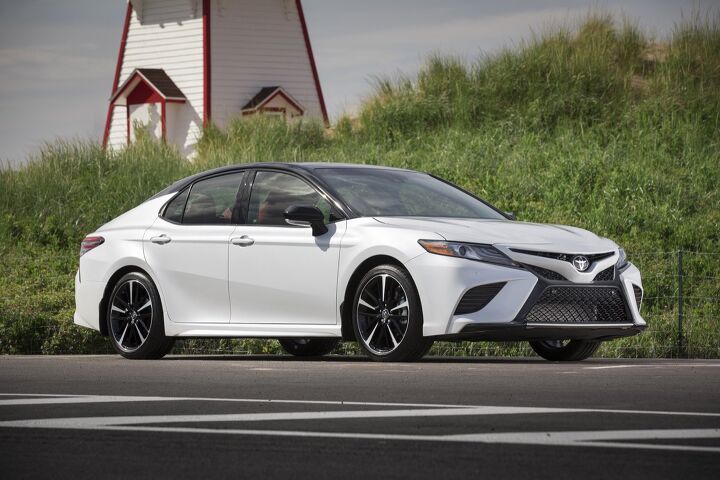Toyota Wouldn't Dream of Ditching Passenger Cars, Has Fingers Crossed It Can Woo Ford Buyers

While fewer competing models in a given segment stands to benefit any automaker left in that realm, Toyota isn’t sure just how loyal Ford car owners are to the Blue Oval brand.
Behind the scenes, there’s surely much licking of chops, but Toyota Motor North America CEO Jim Lentz wasn’t forthcoming with conquest predictions when he talked with Automotive News TV this week. One thing was clear, however. Toyota will remain a full-line brand for the foreseeable future, and the automaker stands to field a more car-heavy product mix for some time to come. And it’s just fine with that.
Fine with it until it becomes a problem, anyways. For now, Toyota doesn’t see much sense in ditching its small passenger cars.
“Especially if you look at the really critical segments — midsize passenger car, compact passenger car — those are two million-plus a year segments. We have no desire to back out of segments,” said Lentz.
“In terms of who may get Ford’s share, it’s difficult to say. If you look at today’s volumes, there’s not a lot of cross-shop between Ford passenger cars and Toyota passenger cars. So it really depends on what happens to those buyers. Are those buyers going to remain loyalists to Ford, and move out of passenger cars and maybe into SUVs — and I’m sure that’s Ford’s strategy — or are they going to remain loyal to passenger car segments? If that’s the case, we’ll have a chance at them with our product.”
Lentz claims Ford brass determined its expertise lies in trucks, and sales numbers surely bears this out. For Toyota, Lentz said, “we’re always going to have a little bias, relative to industry numbers, for passenger cars … we think this is an area we have expertise in.”
Financially, Toyota benefits from fielding a facelifted Mazda as its main subcompact offering. Meanwhile, the Corolla (due for a full revamp for 2020) and recently renewed Camry boast name recognition like no other. A fully updated Corolla Hatchback, replacing the hastily rebadged Scion iM, appears for 2019.
Compared to Ford’s 12.7 percent passenger car volume loss during the first four months of 2018, Toyota-branded cars sales fell just five percent. Models like the Camry and Avalon are up on a year-to-date basis.
As for Toyota’s slow and cautious foray into electric vehicles, Lentz doesn’t see a reason to get out in front if there’s barely a market for the product. There’s 10 battery-electric models on the way, but expect a slow global roll-out. The CEO touted Toyota’s 9 percent hybrid sales rate — a figure well above the recent industry-wide tally of 2.7 percent — after noting the slow growth of U.S. EV sales.
“When the market is ready, when the business is ready, for pure EVs, we’ll be there,” said Lentz. “When the U.S. market is ready, we’ll be able to choose from a stable EVs made somewhere in the world, but in the meantime we’re going to be pushing hybrids.”
[Image: Toyota]

More by Steph Willems
Latest Car Reviews
Read moreLatest Product Reviews
Read moreRecent Comments
- MKizzy I was only into black cars and am on my third black sedan in a row after starting my car ownership life with an inherited blue vehicle. I am starting to change my mindset and will (probably) find another color for my next vehicle. I still love black, but in the 2020s, black vehicles are lost in a grayscale sea piloted by time and financially stressed owners prioritizing resale value and low maintenance over appearance.
- Cla65691460 will you look at that!...no "fix it again tony" jokes from the "best and brightest"
- Mike-NB2 When I ordered my Golf R a while back, I broke with my decades-long tradition of a black car, not because I wanted to branch out a bit, but because there is a certain blue hue that's associated with the R. That blue (Lapiz Blue) is through the exterior trim and interior of the car even if you go with black or white. It's the colour for the R. That's why I chose it. And I'm glad I did.On a related note, I was coming back from a meeting today (in a rental, not my car, so couldn't flag the guy down without looking odd) and came up on a Mk 7 Golf R that was driving rather slowly in the right lane of the highway. It appeared to be black, but as I got beside it, I noticed that it was one of the dark purple hues on the Spektrum palette that was available on the Mk 7. For those who don't remember it, there were standard colours and then there were 40 additional colours for $3500 more. Oddly, the driver was in his 70s, so whether it was his car or not, I don't know. No, that's no slight against an older person driving a performance car. I'll be 58 in a couple of months, so I'm not going to criticize him.
- MrIcky My car is header orange - so basically a safety cone. My trucks have always been white because scratches don't show up as much.
- FreedMike Yeah, this trend needs to die a painful death.


































Comments
Join the conversation
There are four effects in play here: - Some Ford loyalists will move to brands that they perceive to be of higher quality (Honda; Toyota) - Some will move to up and coming brands that they suspect are good value (Kia, Hyundai) - Some will be Murican-only types and will buy a GM or Chrysler product - Some will stick with Ford and move to a Ford SUV. Any guesses as to the sizes of each effect? I would give it 20-20-20-40 percent.
I was stating 2014 Avalon sales, which were around 67,000 plus. Toyota will probably increase Avalon sales by attracting former Taurus owners.